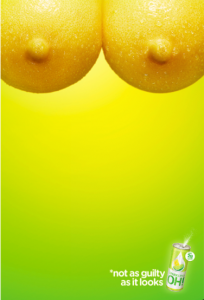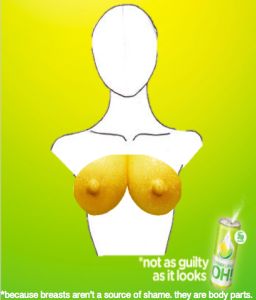- Original Ad

2. Problems with Original Ad
This shot is part of a series that displays different types of fruit as sexualized female body parts. I have focused my analysis on one particular snapshot of this advertisement series. The shape and arrangement of the lemons at the top of the frame resemble an up-close shot of two breasts placed closely together. Additionally, the tag line at the bottom right corner of the frame reads, “not as guilty as it looks”. Presumably, this is meant to convey a message that this brand of soda is not as unhealthy as one might assume. However, with the provocative fruit dominating the frame, this is a clear double-entendre that suggests breasts are “guilty” and/or that the viewer should feel guilty if they assumed these were sexualized body parts.
The problematic aspects of this ad are twofold. First of all, the alteration and positioning of the lemons in order to look like breasts is an example of using the female body to sell products. This type of appropriation is widespread in advertising and remains relatively popular. This essentially objectifies the female body and further perpetuates the idea that women are usable products to sell. The second problematic aspect of this ad comes from the catchphrase, “not as guilty as it looks”. Basically, we are being told that breasts are guilty; whether we show them or look at them, we should be ashamed. This is a part of a grander narrative that is frequently used to justify sexual assault and harassment. This rhetoric typically flips the blame from the perpetrator onto the victim for dressing provocatively, suggesting that the survivor is at least partially responsible for their own assault. By insinuating a connection between breasts and guilt, this advertisement contributes to rape-culture. Furthermore, it upholds a type of victim-blaming that is exceptionally problematic and very harmful for all survivors of sexual violence.
3. Jammed Version

4. Jamming Philosophy
For the jammed version of this advertisement, I decided to address the two main problems I identified: objectification of the female body and the problematic tag line insinuating guilt. In order to desexualize the lemons, I cut them into a less provocative shape and decreased their size so they would no longer be the main focus of the ad. Then, I decided to include a sketched shape of the human body’s upper half and place the lemons on the chest of the cut-out. This successfully desexualises the fruit because the shot is no longer ambiguous and suggestive. The placement of the lemons as breasts on a generic sketch does not objectify the female body because it is not as sexual nor as appealing as the original, zoomed in shot.
So, after I desexualized the lemons, I decided to elaborate on the problematic tag line. I wanted to highlight that breasts are not shameful; they are just body parts that roughly half of the population have. People who have breasts, and show them, are not guilty of being provocative nor are they asking to be harassed/assaulted. I point out the absurdity in even insinuating that breasts can be guilty. The statement I include plays on the subtext of the original slogan to essentially contradict the real message of the advertisement. This new slogan no longer perpetuates rape culture or victim blaming because it is simply stating that breasts are regular body parts.
Overall, I believe that the jammed version really contradicts the original, troublesome messages of the advertisement. I address these issues by removing any sort of ambiguity and highlighting the sexual, problematic nature of this ad. By taking advantage of the double-entendre that was originally used to be suggestive and clever, I was able to effectively flip the message of the advertisement. The jammed version is no longer sexual nor evocative.